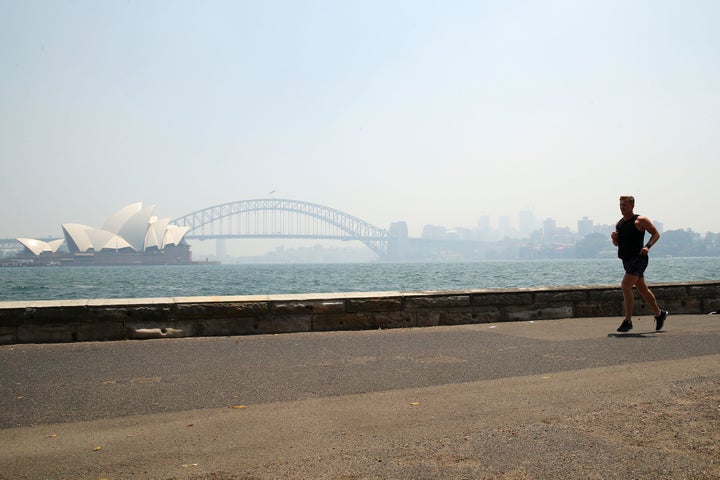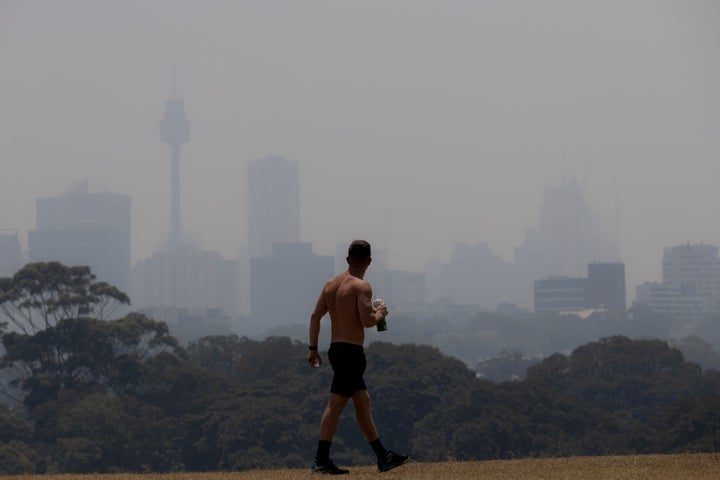
As Australia’s worst bushfire season continues with haze spreading across New South Wales and Queensland in particular, health experts have warned people of the dangers of exercising outside.
Whether or not you have an existing lung or heart condition like asthma, emphysema and angina, doctors say Australians can be affected by the fine particles in smoke. The particles can cause sore eyes, nose and throat for many people, and irritate the respiratory system in more serious cases.
“It’s very concerning,” Dr Beau Frigault, QLD chair of Doctors for the Environment Australia told HuffPost Australia.
“We always recommend that when there is a lot of bushfire smoke in the area, that you’re not doing any strenuous activity outside. Whether it’s your work or recreational exercise, [we say] that you avoid it.”
What Happens To Your Body When You Exercise In The Bushfire Smoke
“When you are exercising, you take more deep breaths in and increase your heart rate,” said Dr Frigault.
“It just promotes taking in more particles deep down into your lungs where they’re more likely to impact those deeper tissues and get into the bloodstream and head towards the heart.
“So that’s why we tell people not to exercise outdoors when bushfires are happening. You can do it inside a gym where it’s air conditioned. That’s more favourable than doing it outside.”

According to Dr Richard Broome, NSW Health Director of Environmental Health, the health impact of bushfire smoke can vary based on a person’s pre-existing conditions.
“For most people, smoke causes mild symptoms like sore eyes, nose and throat,” he said in a statement to HuffPost Australia.
“However, people with conditions like asthma, emphysema and angina are more likely to be sensitive to the health effects of smoke. People with these conditions should avoid outdoor physical activity when there’s smoke around.”
Speaking of the link between respiratory illness and bushfire smoke, Dr Frigault said “it definitely is correlated” and outcomes can be “very severe” if people exercise excessively.
“It’s quite well linked especially if you already have a lung condition,” he said.
“So for kids or adults who have asthma or have pre-existing heart conditions or lung conditions, they definitely will see exacerbation of those conditions. Sometimes that means they will have to come to hospital either for extra respiratory support or to manage chest pain.”
Dr Broome said people should follow their Asthma Action Plan and have their relieving medication and puffers with them as the bushfire season continues.
Where To Exercise During Bushfire Season
It may sound obvious, but working out indoors is your best bet.
However, it’s worth finding out if your gym is well circulated so you can best avoid outdoor smoke and air particles.
“The best option is to do your activity indoors but it’s sometimes dependent on how those facilities work,” said Dr Frigault.
“Air conditioning still brings in outside air into the home or building. So if that air conditioning isn’t set up to recycle the air that’s inside, it’s not necessarily going to be that much better. So doing any kind of strenuous exercise may not be that beneficial. If you know your gym is relatively well circulated then usually that’s pretty safe.”
What Type Of Exercise To Do
Some people’s exercise regimes are built around outdoor activity, and personal trainer Ben Lucas has said if outside workouts are non-negotiable, a compromise could be altering the time spent doing it.
“Be careful when it comes to training outdoors while it is this smokey. If you really want to do it, I would recommend no more than 45 minutes,” said the Flow Athletic founder.
“You can do both strength and cardio work, but limit the intensity to 6/10. For anything more strenuous I would head inside to exercise as you will be putting too much pressure on your lungs.”
He added: “For anyone with respiratory issues such as asthma I would advise that you spend the minimum amount of time outside”.
For people who enjoy more than a brisk walk around the block, Lucas said to tread carefully.
“I would either limit the intensity or volume of hiking/running in the current climate,” he said. “Go for a walk, but again I wouldn’t recommend staying outdoors for more than 45 minutes.”

Poor Air Quality
Bushfires have left at least four people dead and destroyed more than 400 homes since the start of November. Fires are still burning in New South Wales, Victoria, South Australia and Queensland.
NSW was gasping under the worst levels of air pollution ever recorded last Friday as smoke from widespread bushfires caused a spike in hospital visits and hazards including poor visibility for drivers.
Sydney was blanketed in a thick haze for the fourth consecutive day, pushing it into a rare and repeat appearance in the list of top ten cities with the worst air pollution in the world.
Air pollution in Bourke was at 15 times higher than recommended safe levels as strong winds whipped up both bushfire smoke and dust that has accumulated following three years of drought across Australia.
The smoke haze brought particulate pollution, which can be absorbed into the bloodstream, creating what officials said were the highest levels of pollution recorded in New South Wales.
Health officials said 73 people had sought treatment for respiratory conditions over the past week, twice normal levels.
At some stages in recent days, Sydney reached as high as No. 8 on the Air Visual global rankings of cities with the worst air pollution in the world, ahead of Jakarta and Shenzhen and only just behind Mumbai.
With additional reporting by Sonali Paul (Reuters)